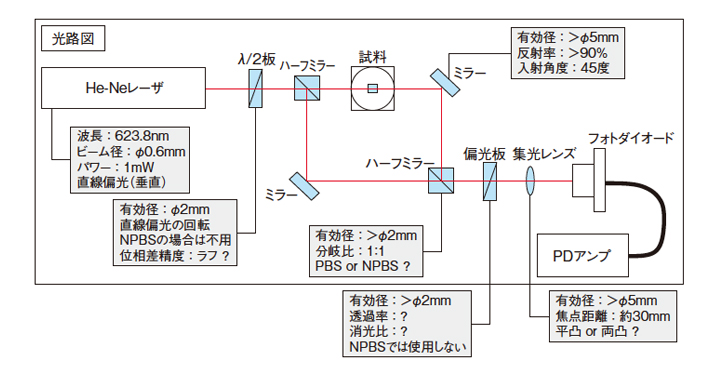光学素子 ガイダンス
ガイダンス
光学素子の選定
光学実験装置や光学系を作るには、まず、実験原理に基づいた光路図を用意します。
この光路図に描かれている光学素子について、どのような要求仕様があるかを一つひとつ確認し、光路図に記入していきます。
この要求仕様を基に光学素子を選択すればよいのですが、カタログには同じような光学素子がいっぱい掲載されており、どのように選定すれば良いか迷うことがあると思います。
ここでは光学素子の選定で重要な2つのポイントについて紹介します。

レーザの仕様
光学素子を選定する時は、最初に使用する『光』の仕様を確認します。光源にはいろいろな種類があります。
このカタログにもレーザ、LED、ハロゲンランプ、メタルハライドランプの光源があります。
レーザの中には色々な波長があり、波長によって使える光学素子が変わります。レーザの波長以外にも光学素子の仕様を決めるいくつかの要素があります。
| レーザの確認項目 | 例1 | 例2 | 関連スペック | |
|---|---|---|---|---|
| レーザ種類 | He-Ne | YAG | 適応波長 | |
| 波長〔nm〕 | 632.8nm | 532nm | ||
| エネルギー密度の計算〔J/cm2〕 (使用者が計算します) (例1)不問 (例2)78J/cm2 |
出射ビーム径 (1/e2、直径)〔mm〕 |
0.59mm | 0.7mm | レーザ耐力0.5W以下のCWは不問 100mJ/cm2以下のパルスは不問 |
|
連続発振(CW) レーザの場合 出力〔W〕 |
1mW | - | ||
| パルスレーザの場合 エネルギー〔J〕, パルス幅〔s〕, 繰り返し周波数〔Hz〕 |
- | 300mJ 10ns, 20Hz |
||
| ビーム拡がり角度(全角)〔rad〕 | 1.35mrad | 1.3mrad | 有効径 | |
| 横モード | TEM00 | シングル | 集光スポット径 | |
| 偏光方向(縦 or 横 or ランダム) | 縦方向 | 水平 | 反射・透過率 | |
上記のような仕様がわからない場合は、レーザのメーカ名と型番を調べ、メーカーに確認を取ります。
カタログに掲載されている光学素子の仕様とレーザの仕様を見比べて、レーザ耐力や偏光方向などの要求仕様を満たしている光学素子を選定します。
光学系のクラス分け
光学素子にどの程度の精度が要求されるかを確認します。具体的な要求精度が分からない場合は、使用用途でクラスを分けます。
- 照明系クラスは精度を必要とせず、その機能を発揮することが優先される場合
- 簡易光学系クラスは機能だけではなく、ある程度の誤差や精度を考慮する必要がある場合
- 干渉計クラスは指定された使用方法で高い精度が要求される場合
| クラス | 面精度 | スクラッチ-ディグ | 製品例 | 使用用途 |
|---|---|---|---|---|
| 照明系クラス | λ程度 | 60-40程度 | 両凸レンズ 非球面レンズ(AGL) |
顕微鏡のランプ照明 ディテクターなどへのビーム集光 |
| 簡易光学系クラス | λ/4以下 | 40-20以下 | 平凸レンズ アクロマティックレンズ アルミ※・誘多膜ミラー |
各種結像系 小径ビームの干渉計 |
| 干渉計クラス | λ/10以下 | 20-10以下 | 面精度保証ミラー フェムト・ハイパワーミラー 集光レンズ |
波面観察干渉計、 レーザ加工装置分解能を高めた 光学実験 |
※アルミミラーの中には高面精度ミラー(TFAQ、TFAN-**-20)もあります。
上記のクラス分けは目安として考えてください。製品や材質によってはこのクラス分けに当てはまらないものもあります。
個々の製品の選定に関してはセレクションガイドを参考にしてください。
また、セレクションガイドやアプリケーションノートには『ビームの拡大方法』や『偏光素子の使い方』などの説明が記載されていますので、ご活用ください。
もし、分からないことがあれば、営業までお問合せください。
お問合せいただくときに、レーザの仕様や使用用途の情報を事前に頂ければ、無駄なやりとりを少なくでき、より実状にあった回答をさせていただきます。

